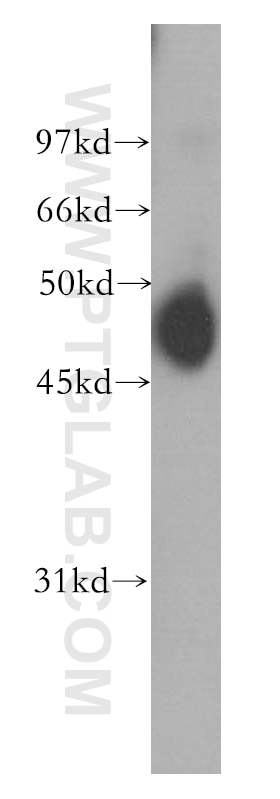CCRL2 Polyklonaler Antikörper
CCRL2 Polyklonal Antikörper für WB, ELISA
Wirt / Isotyp
Kaninchen / IgG
Getestete Reaktivität
human und mehr (1)
Anwendung
WB, ELISA
Konjugation
Unkonjugiert
Kat-Nr. : 13387-1-AP
Synonyme
Geprüfte Anwendungen
| Erfolgreiche Detektion in WB | A431-Zellen |
Empfohlene Verdünnung
| Anwendung | Verdünnung |
|---|---|
| Western Blot (WB) | WB : 1:500-1:2000 |
| It is recommended that this reagent should be titrated in each testing system to obtain optimal results. | |
| Sample-dependent, check data in validation data gallery | |
Veröffentlichte Anwendungen
| WB | See 2 publications below |
Produktinformation
13387-1-AP bindet in WB, ELISA CCRL2 und zeigt Reaktivität mit human
| Getestete Reaktivität | human |
| In Publikationen genannte Reaktivität | Ratte |
| Wirt / Isotyp | Kaninchen / IgG |
| Klonalität | Polyklonal |
| Typ | Antikörper |
| Immunogen | CCRL2 fusion protein Ag4045 |
| Vollständiger Name | chemokine (C-C motif) receptor-like 2 |
| Berechnetes Molekulargewicht | 344 aa, 40 kDa |
| Beobachtetes Molekulargewicht | 47 kDa |
| GenBank-Zugangsnummer | BC025717 |
| Gene symbol | CCRL2 |
| Gene ID (NCBI) | 9034 |
| Konjugation | Unkonjugiert |
| Form | Liquid |
| Reinigungsmethode | Antigen-Affinitätsreinigung |
| Lagerungspuffer | PBS with 0.02% sodium azide and 50% glycerol |
| Lagerungsbedingungen | Bei -20°C lagern. Nach dem Versand ein Jahr lang stabil Aliquotieren ist bei -20oC Lagerung nicht notwendig. 20ul Größen enthalten 0,1% BSA. |
Hintergrundinformationen
Chemokine CC motif receptor-like 2 (CCRL2) is a seven-transmembrane domain receptor that shares structural and functional similarities with the family of atypical chemokine receptors (ACKRs) (PMID: 28743719). CCRL2 does not appear to be a signaling receptor, but may have a role in modulating chemokine-triggered immune responses by capturing and internalizing CCL19 or by presenting RARRES2 ligand to CMKLR1, a functional signaling receptors. CCRL2 has been found on almost all hemopoietic cells, including monocytes, macrophages, polymorphonuclear neutrophils (PMNs), T cells, dendritic cells, natural killer cells, and CD34+ progenitor cells, with PMNs expressing the highest levels (PMID: 15188357). CCRL2 is also expressed by barrier cells, such as lymphatic and blood endothelial cells and bronchial and intestinal epithelial cells (PMID: 29056935).
Protokolle
| PRODUKTSPEZIFISCHE PROTOKOLLE | |
|---|---|
| WB protocol for CCRL2 antibody 13387-1-AP | Protokoll herunterladen |
| FC protocol for CCRL2 antibody 13387-1-AP | Download protocol |
| STANDARD-PROTOKOLLE | |
|---|---|
| Klicken Sie hier, um unsere Standardprotokolle anzuzeigen |
Publikationen
| Species | Application | Title |
|---|---|---|
Aging (Albany NY) RNA-seq analysis of the key long noncoding RNAs and mRNAs related to cognitive impairment after cardiac arrest and cardiopulmonary resuscitation. | ||
Pflugers Arch Chemerin-9-induced contraction was enhanced through the upregulation of smooth muscle chemokine-like receptor 1 in isolated pulmonary artery of pulmonary arterial hypertensive rats. |


